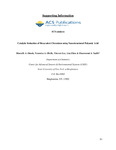| dc.description.abstract | This paper provides a survey of conventional and emerging techniques that are available for characterizing engineered nanoparticles in complex matrices. Techniques that were considered include microscopy (TEM, SEM, HRTEM, DLS, SNOM), chromatography (HDC, FFF), mass spectroscopy (ICP-MS, SEC-ICP/MS, MALDI, FFF-ICP-MS), sp-ICP-MS, and electrochemical techniques. A case study is presented from the authors’ laboratories for the design of a portable nanoparticle analyzer based on tangential flow filtration and electrochemical detection (EC-TFF). EC-TFF is equipped with poly(amic) acid membrane filter electrodes (PMFE) arrays that perform multiple functions to capture, isolate, and detect (CID) engineered nanoparticles. The application of EC-TFF is presented for the characterization of engineered nanosilver in real-world samples. A size-dependent isolation of AgNPs was achieved at varying particle sizes with over 98.5% removal efficiency. PEC-TFF AA showed an excellent performance not only for isolation at subnanometer-sized ranges but also as a platform for detection of engineered nanoparticles at low ppb levels. | en_US |

